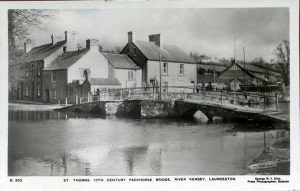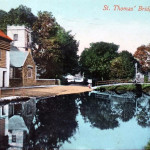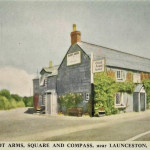.

St. Thomas Church which stands on the southern margins of the river Kensey, started its life as a Chapel sharing the ground with the stately priory, but with an independent existence. Before the canons of St. Stephens laid the foundations of their sumptuous chapter-house, the parson or vicar of St. Thomas exercised his religious edifice; and, throughout the four centuries of the life of the priory, a separate chaplain continued his ministrations there, side by side with his Augustine brother. Monasteries and priories were not parishes; they were within parishes, empires within empires, often supplying from their own bodies the parochial chaplain or priest, while conducting also devotional offices in their own cloisters. Parishes has become general. Perhaps universal, long before the establishment of the Launceston Priory, and tithes were, as a rule, payable for the support of the minister officiating in the parish where the lands were situate. As Christianity extended, the owners of lands began to build churches upon their demesnes, to accommodate their tenants, and , in order to have divine service regularly performed therein, obliged all their tenants to appropriate their tithes to the maintenance of the one officiating minister. This tract of land, the tithes whereof were so appropriated, formed a distinct parish, which will account for the frequent intermixture of parishes one with another.
The combined parish and hamlet of St. Thomas may illustrate by their boundaries an irregular ecclesiastical circuit. These boundaries are: On the east, Ridgegrove Mill Hill, as it descends from Dockacre; and on the west, Carnedon and Hill Park, five miles distant. Its eastern portion is thus a mere strip between the town wall of Dunheved, and the river Kensey, but widening and sinuous along its northern and southern margins to the western limit. The canons of St. Stephens were lords of the contiguous manor of Launceston at the compilation of Domesday, and the MSS, which are seen at Lambeth, show their continual acquisition of lands, advowson’s, and tithes in the neighbourhood. Beyond all question, these canons were, in 1288-91, im-proprietors of the tithes of St. Thomas; and the chapel is at that time distinctly recognized by the taxation of Pope Nicholas. The cemetery of St. Thomas was dedicated on November 6th, 1333.
The mayor and commonalty of Dunheved had considerable territorial possessions in the parish of St. Thomas. They were owners of Bas Strete (St. Thomas street, or Old Hill (below), the only road which led from Northgate to St. Thomas Bridge, the original ‘hamlet’ or cluster of houses, and the most densely populated part of the parish). They held also the adjacent Bodier’s Quarry, and other lands eastward of it; while they had larger possessions around St. John’s Chapel, and by the Deer Park to the old Pennygillam Cross, near Tresmarrow. This ownership gave them an important interest in the affairs of the church of St. Thomas.
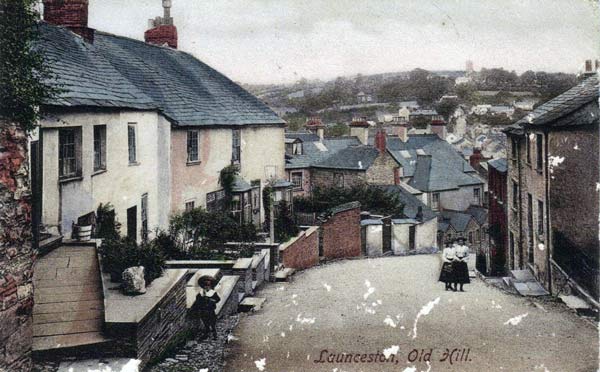
Therefore its no surprise at the contention between them and the Prior and Convent of Launceston. In 1400 the parishioners of Liskeard, Linkinhorne, and Talland complained in Parliament that the Prior of Launceston had, on the ground of poverty of his Convent, obtained a Papal Bull for the extinction of those vicarages, and the complete appropriation of their revenues. The petitioners stated that the Convent had an annual income of one thousand pounds, which was enough for its fifteen Canons. The Pope revoked the bull on discovery of the facts. By indenture made between Stephen, Prior of Launceston, and the Convent of the same place, on the one part, and Richard Cobbethorn, Mayor of the borough of Dounheved, and the Commonalty of the same borough, of the other part, after reciting that strife and discord had arisen concerning divers liberties and franchises within the said borough of Dounheved, it was agreed as follows:
“That the aforesaid Mayor and Commonalty shall have for themselves and their successors, and shall exclusively enjoy, the liberty or franchise of the same Borough on the Eastern part of Harpery’s Lake, descending by the same Lake as it was wont to run of old by the garden of the Prior, as far as Sextenyshaye, and so by the middle thereof even to the Fulling Mill, on the west part of the same mill, and thence to the water of Kensi on the west part of the Chapel of St. James, without any hindrance or disturbance of the aforesaid Prior and Convents, saving always to the aforesaid Prior and Convent and their successors a certain fair called Waterfeire, with all its profits and emoluments, as they were accustomed to have of old, with impediment or hindrance of the said Mayor and Commonalty; and the aforesaid Mayor and Commonalty ratify and by these presents confirm the estate of the aforesaid Prior and Convent and their successors, of all in all steps, porchys, and stoorys of the building or linhay (wool store) in their tenements within the liberty aforesaid in Vastehaye, and also of and in all messuages, tofts, lands, tenements, rents and other acquisitions by the aforesaid Prior and Convent and their successors, or of John Tregorrek and others, whosoever, within the liberty aforesaid, which are held of the aforesaid Mayor and Commonalty shall not have, nor claim to have, road or passage by Sextenyshaye to the Church of St. Thomas, near the Priory aforesaid, that is to say, they by these presents relinquish for ever the bottom road or way to the aforesaid Prior and Convent.”
The witnesses to this indenture are Thomas Kelly of Kelly, Thomas Polsa, Stephen Bant, Richard Reprynne, John Treludek, and others. (It is assumed that Harper’s Lake is the stream descending from Chapple to Maidens Wells near the head of Wood Lane, and flowing thence, in nearly its present channel, to the Kensey River in St. Thomas. The Prior’s garden probably occupied the area around where the Bowling Club stands. The Sextenyshaye was possibly Wooda Lane leading into what is now St. Thomas Churchyard. The mill was distinct from what is now known as Town Mills. It evidently stood near to the place where the old bone mill, at the eastern end of St. Thomas Church, between what was Hender’s wool-house and Mr. Burt’s yard. The water, after passing that mill, united with the Kensey not far from where it still enters the river. The Chapels of St. James must therefore have been on the Launceston side of the streamlet called Harper’s Lake, and have occupied part at least of the old Newport Post Office site. The Convent garden, the , the Priory, and the churchyard were outside of the boundary of Launceston). The Water-fair clearly yielded some pecuniary benefit to the Convent. It is unknown what the usages of the fair was, but its safe to assume that they included amusements and diversions on the broad piece of water which, even then, occupied the river bed above the existing footbridge at St. Thomas. In Norman French the word ‘feire’ indicated places in which the wakes or feasts of dedication of churches were held.
The agreement, dated September 4th, 1400, which terminated that strife, shows a reservation of the privileges of the ‘Waterfeire’ to the prior and convent; that they were to be permitted to hold in peace some steps, and other probable encroachments, and to enjoy the messuages and tenements which they had acquired from John Tregorrek and other persons, subject to the ancients rights of the mayor and commonality therein.
On Wednesday, September 24th, 1438, a quarrel between ‘two men of the town Launceston’ took place in St. Thomas churchyard with one being a fisherman named Robert Symon. Blood was apparently shed, which at the time was deemed a pollution of the place. It is said that, although a great pestilence was then reigning, all interments in the cemetery were suspended until the pollution had been expurgated. A solemn enquiry took was therefore held in the chapel of St. Thomas with the court consisting of T. Uppton, Esq., Who sat for John Stevyn, the Mayor of Dunheved; Nicholas Tregodeck, William Stoterych, and others. Robert Symon was found to be guilty but there is no record of his punishment.


Around 1482, there were costs incurred in the purchase of bells, and the repairing of the bell tower. The lower portion of the existing tower bears intrinsic evidence of having been erected or reconstructed at about this time. The same may be safely said of the church, except as to the south porch, which is a little more recent. Both church and tower unquestionably occupy the site of a former church or chapel. It was an almost universal practice to rebuild on ground once appropriated to ecclesiastical edifices. When St. Thomas church was restored in 1871-72, a painting of the Roman Catholic legend of St. Roche (below left) was discovered on the plaster under the lime-wash at the eastern end of the building. The saint was in pilgrim’s habit, an angel bringing ointment for his wounds, and a dog carrying bread for his hunger.

The entrances are a south porch, a priest’s door, and a vestry door on the eastern pier of the porch are a suspended fleece and two Catherine wheels carved in stone. Two apparently very old stones are built into the present porch, and near the church is the commencement of a subterranean passage, leading, it is believed, to Launceston Castle, and by which access to the River Kensey flowing near it could be had in time of siege. The tower arch is narrow, lofty and plain. The tower has three stages, the parapet being embattled; the belfry contains three bells, two of which bear the following legends: 1. “When I am heard it pleaseth you, 1691” ; 2. “John Turner, V., Simon Kestle and John Nance Ch. dns, 1739” Floor stones :- – – – – – – – in the churchyard – – – The cemetery was consecrated by Bishop Grandisson November 6th 1333. There is an old tradition that the priest formerly occupied a room in the tower, “the better to be ready for the duties of his office,” and that the church was bound to supply candles for certain religious festivals to St Stephen, which is said to have been the mother church. A small square opening in the tower, with iron grating, has given rise to various surmises as to its original intention. One opinion is that it was used to give the Lord’s Supper to lepers, (not allowed to come among the congregation) which idea is based on the fact that there was formerly a leper hospital in the neighbourhood. Others have thought its purpose was for observing of the Paschal light kept burning at the east end near the altar, an old bracket which projects from the wall giving some colour to this idea.
In the 1871 restoration, in the eastern window of the north aisle were found remains of very ancient stained glass, among which were two shields, bearing the emblems of the crucifixion (the scourges, the nails, and crown of thorns, and even the dice which the soldiers threw in casting lots). In the centre a larger shield contained what was supposed to be the arms of the Abbot of St Austin. That this coat of arms belonged to some person of note is evident from the fact of a seat-end being discovered with the same arms elaborately cut in oak. The font in St. Thomas church is remarkably beautiful, and it has its counterparts in design both at Lawhitton and Altarnun, and is undoubtedly older than the present church. The bowl is square and has sculptured human heads at the angles and stars or Catherine wheel on its sides; the shaft is octangular and rests on a cable moulding and a square plinth with carved angles. The material is Polyphant stone. The massiveness and superior character of the font induces a belief that it once belonged to the ancient religious establishment of which this locality was the site.




The Parish Church of St Thomas the Apostle
Shades of the dim and distant ages past
Are lingering yet around these ancient walls,
In this retreat where stood St Austin’s halls;
Nought of whose former glory doth outlast
Time’s ravages, for e’en the name is fading fast.
Time-honour’d spot, thy leafy rural bower,
How calm and peaceful in its deep repose,
On Sabbath morn or dewy evening’s close
Meet stillness reigns that suits the solemn hour:
All things around thee Nature’s beauties wear:
Sweet sylvan scene, – we love to wander there!
Clad in its vesture bright of summer green,
Here the long avenue to musing leads:
Unheard, the neighbouring stream in silver sheen
Runs gently by to glad the distant meads.
Church of our fathers ‘mid this beauteous glade
Here dost thou stand apart in sombre shade!
S.C.C.
Newport and St. Thomas, although in different parishes, were locally divided only by the Kensey. The river, spanned by its bridge, was no barrier to intercourse among the residence on its banks. Newport was then more populous, and with the proximity of St. Thomas Church as compared with that at St. Stephen’s, naturally led the inhabitants of Newport to worship at St. Thomas. The chapel of St Catherine stood in the parish; it was prophaned in Leland’s time, circa 1540.
In 1558 both the Lent and Lammas Assizes for Cornwall were held in the adjoining borough of Dunheved, and the victims of the savage laws of the time were hanged in the keep court of the Castle (Castle Green). The dead bodies were borne to St. Thomas churchyard, either in carts, or on biers – frames of wood known as ‘ladders,’ and possibly resembling a handbarrow. In the churchyard a pit was dug for them, the bodies were washed, and then cast into their earthen bed. No register reveals the name, the sex, or even the fact of interment, of these friendless, hapless creatures. On 24th August, 1957, Launceston Town Council agreed the change of name from Packhorse Bridge, St Thomas to Prior’s Bridge, St Thomas (below).
St. Thomas Street (Old Hill) and a little cluster of houses at Tregadylet, always supplied a the large proportion of the population resident within the parochial boundary. Trethorne, Carnedon, Tresmarrow, Landreyne, Dockacre, and Tredidon represented a majority of the scattered homesteads in the parish.
The barton of Carnedon was purchased in 1690, of John Blighe, Esq. by John Cloberry, Esq. But in 1700, it was sold by trustees to Mr. Nicholas Clark, for the payment of debts which Mr. Cloberry had contracted. In 1715, it was sold by Mr.Clark.
The barton of Tredidon belonged anciently to a family of that name; from whom it passed by successive heirs, to the families of Windsor and Jolliffe. In this latter family it remained for many generations, after which it was in the family of French before it was purchased by the Rev. Simon Webber in 1805.
Methodism came to Tregadillet in the late 18th century and the first Methodists met in each others homes, until they erected a small chapel in the village. In 1821, this chapel was replaced but during its construction, the money ran out, and for a short time all work on it stopped, but under the leadership of William Hockaday, the society managed to raise the necessary money, and the work was completed. The Tregadillett Society first appeared on the Launceston Circuit Plan in December 1798, under the name of Corckadillett. The minister in Launceston was the Rev. Richard Treffry. In September 1873 a new chapel was opened by William Sims, to a design by the Launceston architect Charles Wise and built by Mr. J. Congdon of Newport.
East Cornwall Times. August 1872: Advertisement:
“Tenders are invited to Build a New Wesleyan Chapel at Tregadillet. CP Wise, Architect.
New Chapel at Tregadillet: The foundation stone of a new Wesleyan chapel at Tregadillet, will be laid on Tuesday, 8th October, 1872, by William Sims, Esq., of Lifton. The following are the services for the day: At 2.30. a Sermon in the old Chapel by the Rev. William Hurt, of Plymouth, chairman of the district; at 4. the Foundation Stone will be laid by Mr Sims; at 5, a Tea will be provided in a large marquee. At 6.30. a Public Meeting, presided over by Mr Sims, Rev W Hurt, the Ministers of the Circuit, and other Gentlemen, will be present. Tea – 1s. Collection will be made as usual. August 5th. 1872.
East Cornwall Times, 12 Oct, 1872:
New Chapel at Tregadillet. Mr Robert Jackett, though not in any way connected with Methodism, and at great inconvenience to himself, sold a plot of land to the Building Committee, thereby provoking the wrath of his ‘spiritual advisor,’ but setting him an example of brotherly love and Christian catholicity, which he would do well to emulate.
Subscriptions amounting to £230. have been promised, the committee saw the way opened to commence with the new erection. Accordingly a design was submitted by Mr C Wise, architect, Launceston, and adopted. The building is to be in the Early Decorated style of architecture, the front gable will have a handsome window, the lights of which, as well as those in other windows, will be composed of leaded Cathedral glass, with coloured margin. The rood will be open to the ridges, and stained and varnished. The pews will be of pitch pine. The aisles and floor of the communion are to be laid with Minton tiles. The windows will be of Bath stone, the arches of Polyphant stone, and the walls of stone from neighbouring quarries. The entrance will be at the side, under the spire, which is to be 50 feet high, and to carry a bell, which shall invite the people to worship; sitting accommodation will be provided for 160, in short, the design combines strength and beauty, with thorough economy and comfort —. Not less than 300 people attended the ceremony – —. The ceremony commenced by the Rev TB Butler giving an appropriate hymn, after which a portion of scripture was read by the Rev Mr Daniel [Bible Christian], and prayer offered by the Rev TB Harrowell. Mr Orchard, on behalf of the Trustees, then presented a handsome silver trowel [suitable engraved] to Mr Sims, Esq., of Lifton, who proceeded to lay the stone in a work-manlike style. Mr Sims then ascended the stone and made a brief and excellent speech, which he brought to a practical conclusion by depositing on the stone £25. Thereupon a bottle containing various papers was placed in a cavity in the stone, and a collection being made brought the ceremony to a close.
Mr Dingley gave a statement of their financial position, from which it appeared that the building would cost about £680. of which sum £230. had been promised.
Launceston Post and News: 23 November, 1872: The Mission School Chapel, at Tregadillet.
The corner stone of the new Mission School Chapel at Tregadillet was laid on Wednesday last, by Miss Anna Maria Gurney, of Trebursye. The land, which consists of half-an-acre, was given by Colonel Deakin, Werrington. The building will consist of a spacious schoolroom, with class-room adjoining. A silver trowel was presented to Miss Gurney by the Reverend S C Clarke.
Launceston Post & News 3rd. August, 1878. New Mission Chapel Opened by Bishop at Tregadillet.
The Rev, S. Childs Clarke, formally resident in this locality, must have felt considerable satisfaction on witnessing the opening by the Lord Bishop of the diocese, on Tuesday last. Not less must have been the feelings of Mr C Gurney, Esq., of Trebursye, who took such n interest in the work. The building, which had been beautifully decorated for the occasion by Miss Gurney and Miss E Michael, the schoolmistress, is of a very neat and pretty design, the architect be Mr JP StAubyn, Plymouth.
It possesses an open roof, with lancet-shaped windows, and the east end is semi-circular. Though we describe this as an opening ceremony, we may here state that the main body of the building has been for some time in use for ordinary services and the purposes of the Sunday School, but it was the chancel to which the word ‘opened’ more truly applies. This can be screened off by shifting shutters, whilst the rest of the edifice can remain open for any purpose. A neat font stands opposite the Communion table, the chancel floor is prettily tiled, and that of the sacranium is raised. Near a recess for the organ –when one can be procured – are some chaste choir stalls- –
St. Thomas Church and Parish Gallery
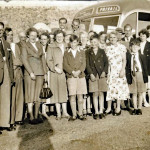

Visits: 291

